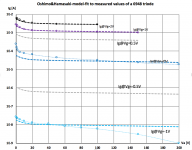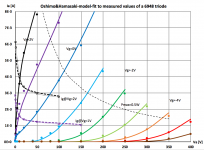Hi skitron
You will find a "freshly baked" 6814 spice model on my website:
http://adrianimmler.simplesite.com/440956786
all the best, Adrian
You will find a "freshly baked" 6814 spice model on my website:
http://adrianimmler.simplesite.com/440956786
all the best, Adrian
* 6814 LTSpice model
.subckt 6814 P G K
Bp P K I=(0.04914253316m)*uramp(V(P,K)*ln(1.0+(0.395882325)+exp((14.27650748)+(14.27650748)*((32.63476104)+(244.1821113m)*V(G,K))*V(G,K)/sqrt((18.51822259)**2+(V(P,K)-(-16.26736996))**2)))/(14.27650748))**(1.321509761)
.ends 6814
Hello !
Sorry, but this model doesn't seem to works with LTSpice
May be I've done something wrong ?
Do happen to have that 6973 model 3f4?Code:.SUBCKT 6973 1 2 3 4 ; A G2 G1 C (Pentode) * RCA data sheet * library format: LTSpice 14-Nov-2009 +PARAMS: MU=13.58 EX=1.350 KG1=1142.2 KG2=4500 KP=27.70 KVB=18.4 VCT=0.00 RGI=2000 CCG=4.3p CPG1=0.6p CCP=5.1p RE1 7 0 1MEG ; DUMMY SO NODE 7 HAS 2 CONNECTIONS E1 7 0 VALUE={V(2,4)/KP*LOG(1+EXP((1/MU+V(3,4)/V(2,4))*KP))} ; E1 BREAKS UP LONG EQUATION FOR G1. G1 1 4 VALUE={(PWR(V(7),EX)+PWRS(V(7),EX))/KG1*ATAN(V(1,4)/KVB)} G2 2 4 VALUE={(EXP(EX*(LOG((V(2,4)/MU)+V(3,4)))))/KG2} *G2 2 4 VALUE={PWR(if( V(2,4)/MU+V(3,4) < 0 , V(2,4)/MU+V(3,4), 0 ) ,EX )/KG2} *G2 2 4 VALUE={(PWR(V(7),EX)+PWRS(V(7),EX))/KG2*(2.5708-ATAN(V(1,3)/KVB))} RCP 1 4 1G ; FOR CONVERGENCE A - C C1 3 4 {CCG} ; CATHODE-GRID 1 C - G1 C2 1 3 {CPG1} ; GRID 1-PLATE G1 - A C3 1 4 {CCP} ; CATHODE-PLATE A - C R1 3 5 {RGI} ; FOR GRID CURRENT G1 - 5 D3 5 4 DX ; FOR GRID CURRENT 5 - C .MODEL DX D(IS=1N RS=1 CJO=10PF TT=1N) ; .ENDS
Oshimo&Hamasaki vs. Immler-Triode-Approach
Hi all,
to satisfy my commitment I have given in #1895, here is the short comparison of the Oshimo & Hamasaki triode model vs. my generic approach. Both model were introduced in Oct 2018 and are able to mimic also the initial velocity grid current.
fit quality:
the O&H model need 17 parameters and is able to deliver a good fit quality, I would say similar the the Cohen & Heile model (12 parameters), but not as precise as my approach (14 Parameters).
See attached graphs.
calculation speed
the O&H model is around 20% faster than mine, and comparable to Ayumi's model.
parameter independence
the O&H model suffers under strong parameter interactions, making it difficult to find good fits. The least mean square method seldom delivers good results with this model, you better do that manually.
convergence performance
The main problem of the O&H model is, that the Ia-traces for positive Vg do not inherently cross the origin of the Ia and Va axes. It is a manual playing with the parameters to ensure this. When this task is not made proper, a Vg increase could lead to Ia reduction at certain working points, leading to convergence problems.
This is solved much better it most triode spice approaches, including mine.
all the best, Adrian
Hi all,
to satisfy my commitment I have given in #1895, here is the short comparison of the Oshimo & Hamasaki triode model vs. my generic approach. Both model were introduced in Oct 2018 and are able to mimic also the initial velocity grid current.
fit quality:
the O&H model need 17 parameters and is able to deliver a good fit quality, I would say similar the the Cohen & Heile model (12 parameters), but not as precise as my approach (14 Parameters).
See attached graphs.
calculation speed
the O&H model is around 20% faster than mine, and comparable to Ayumi's model.
parameter independence
the O&H model suffers under strong parameter interactions, making it difficult to find good fits. The least mean square method seldom delivers good results with this model, you better do that manually.
convergence performance
The main problem of the O&H model is, that the Ia-traces for positive Vg do not inherently cross the origin of the Ia and Va axes. It is a manual playing with the parameters to ensure this. When this task is not made proper, a Vg increase could lead to Ia reduction at certain working points, leading to convergence problems.
This is solved much better it most triode spice approaches, including mine.
all the best, Adrian
There it is:Cool, thank you rankot!
Do you also have a graph of the fit quality?

I think it's pretty close
Hi Adrian,Hi all,
to satisfy my commitment I have given in #1895, here is the short comparison of the Oshimo & Hamasaki triode model vs. my generic approach. Both model were introduced in Oct 2018 and are able to mimic also the initial velocity grid current.
Is there a tool to create tube models with your approach, like triode paint tool that I found on Internet? I used that one to create some triode models.
Hi JackAdrian
You should write a response to the JAES -- then you get get your PhD!
Well I guess that would really lead to a PhD - but im not keen on.
What me would satisfy much more, is to see that my approach would be used by others to generate tube models. 9 month after introduction, it seems that i'm still alone on this world doing so...
all the best, Adrian
Hi rankotHi Adrian,
Is there a tool to create tube models with your approach, like triode paint tool that I found on Internet? I used that one to create some triode models.
Unfortunately, I havent such a tool - just using LTspice and a semitransparent graph of the datasheet or selfmeasured data. It works, but is't very convenient.
Do you perhaps have the skills to develop a suitable tool?
all the best, Adrian
...and rankot, you did a very good job for your 6h21b model, congratulations!
Unfortunately, I have quit programming long time ago 
Maybe you can contact guy who wrote this pentode/triode paint apps and ask him to adjust them to use your equations? It must be easier to modify them, instead of writing new ones! Model Paint Tools: Trace Tube Parameters over Plate Curves, Interactively
Maybe you can contact guy who wrote this pentode/triode paint apps and ask him to adjust them to use your equations? It must be easier to modify them, instead of writing new ones! Model Paint Tools: Trace Tube Parameters over Plate Curves, Interactively
Hi kissabout2002
My approach is suitable for most triodes, but not for all. For example all variable-mu triodes will not be fitted well with my model, and also the section 1 of the 6EW7.
This is because this triode shows two very unusual characteristics according the Sylvania datasheet:
1) The Ia traces for positive Vg values don't start at zero
2) The Ig traces for positive Vg values don't decrease continuously with rising Va
So, applying my approach doesn't make sense for the 6EW7, sorry !
!
kind regards, Adrian
My approach is suitable for most triodes, but not for all. For example all variable-mu triodes will not be fitted well with my model, and also the section 1 of the 6EW7.
This is because this triode shows two very unusual characteristics according the Sylvania datasheet:
1) The Ia traces for positive Vg values don't start at zero
2) The Ig traces for positive Vg values don't decrease continuously with rising Va
So, applying my approach doesn't make sense for the 6EW7, sorry
 !
!kind regards, Adrian
- Home
- Amplifiers
- Tubes / Valves
- Vacuum Tube SPICE Models


